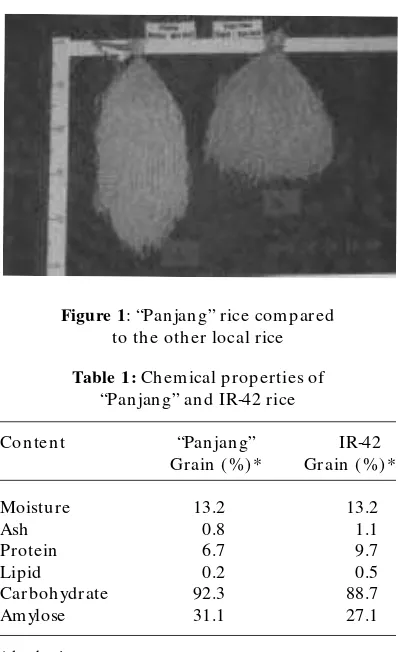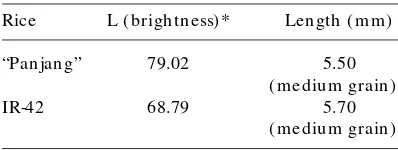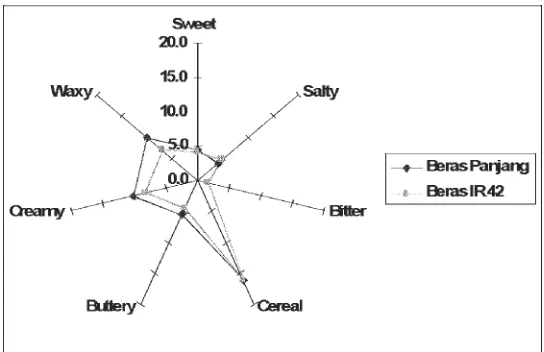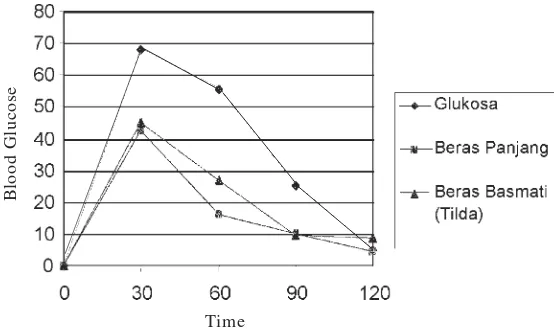Physico-Chemical Properties, Sensory Characteristics and Glycemic
Index of Tidal Peat-Swamp Rice Grown in South Kalimantan
*1
Wijaya, C.H .,
1Bern ard,
2Pur n omo, E. an d
3H ash idoko, Y.
1Department of Food Science and Technology, Faculty of Agricultural Technology,
Bogor Agricultural Institute (IPB),
Bogor Agricultural University, Campus IPB Darmaga PO Box 220, Bogor 16002, Indonesia 2Department of Soil Science, Faculty of Agriculture, University of Lambung Mangkurat, Indonesia
3Department of Applied Bioscience, Faculty of Agriculture, Hokkaido University,
North 9 West 9 Sapporo 060-8589, Japan
Abstract: “Panjang” rice is an ethnic rice strain found in a tidal peat swamp Aluh-Aluh, South Kalimantan. A series of analyses on its sensory and physico-chemical properties included proximates, mineral content, amylose content, starch gelatinization, grain size and color were carried out to compare its quality to that of the commercial wet-land rice. Its glycemic index was also measured to explore its low glycemic potency. “Panjang” rice was classified as a medium sized grain (5.50 mm length) with high amylose content of 31.1% (db), gelatinized at 77.3oC with gelatinization peak at 97.5oC and maximum viscosity at 637.5 BU. T here were significant differences between “Panjang” rice and IR 42 in ash, fat, protein, carbohydrate, and mineral (Na, S and P) contents, amylose content as well as grain brightness. No significant (p<0.05) difference was observed in sensory properties between ”Panjang” and”“IR 42” cooked rice, except that no bitter taste was sensed in “Panjang” rice . Based on its glycemic index, which”was as low as 46.8, “panjang” rice can be classified as low glycemic index rice.
Keywords:“Panjang” rice, tidal peat-swamp, physico-chemical properties, sensory, glycemic index
INTRODUCTION
Rice is a stap le food to m ost In d on esian s. H owever, th e h igh con sumption of rice is n ot supported by th e domestic rice production . In don esia is th e biggest rice importer in th e world. Total rice import of In don esia in year 2003 was 1.6 million ton s ( IRRI, 2005) .
Kaliman tan Islan d h as 2 million h ectares of tid al p eat m oss soil, wh ere on ly 135,000
h ectares is plan ted with rice ( Noorsyamsi et al.,
1984) . Most of th e plan ted rice is eth n ic such as “Bayar Ku n in g”, “Bayar Pu tih ”, “Pan d ak Putih ” an d “Siam Dukuh ”. Th eir productivity
is on ly 1.0 – 2.5 ton s h a-1. South Kaliman tan is
th e biggest rice producer in Kaliman tan Islan d; with th e amoun t of production in year 2004 stan din g at 1.5 million ton s of rice grain ( BPS, 2005) .
“Pan jan g” rice wh ich is also called “Padi Pan jan g” is eth n ical rice wh ich was foun d in Aluh -Aluh district, South Kaliman tan , in 1990 by local farmers. Th e h eigh t of th e rice reach es 2.5 m , a n d t h e st a lk 50 cm lo n g. I t ’s productivity is h igh , reach in g 6.7 ton s grain
yie ld h a-1, with o u t an y n itr o ge n fe r tilize r
ap p licatio n ( Pu r n o m o et al., 2004) . It is
cultivated in tidal peat swamp, a sulph on ic lan d wh ich is h igh in acid it y, r ich in o r gan ic elemen ts an d h igh in min eral con ten ts.
establish ed com m ercial rice in th e m arket. Th erefore, th is research was car ried ou t to o b t a in m o r e scie n t ific in fo r m a t io n o f “Pan jan g” rice regardin g th e sen sor y, ph ysical an d ch emical attributes of its grain , as well as th e glycemic in dex of its rice. Th e glycemic in d ex was m easu red to exam in e th e oth er bioch emical ch aracteristics of th is “Pan jan g” rice.
MATERIALS AND METHODS
Dried m illed “Pan jan g” grain was obtain ed fr o m t h e De p a r t m e n t o f So il Scie n ce , Lam bu n g Man gku r at Un iver sity an d d r ied milled IR-42 grain was obtain ed from th e local market in Bogor. Basmati grain ( Tilda Bran d, Australia) was bough t in Jakarta Super market in h ulled sh ape an d ready to use.
Th e d r ied m illed “Pan jan g” gr ain an d dried milled IR-42 grain were de-h usked an d h ulled to get total h ulled rice.
IR-42 rice was used to compare with th e “Pan jan g” r ice fo r p h ysical an d ch e m ical attributes an d sen sor y an alysis, wh ile Basmati rice was used for comparison of th e glycemic in dex.
Pu r e am ylo se ( Sigm a, U SA) , glu co se stan dard, min eral water an d oth er ch emicals utilized for th e measuremen ts were obtain ed fr om Br ataco ch em ical su p p lier in Bogor. Flavor stan dards such as lauric acid, diacetyl, acetyl meth yl carbin ol, oat meal, aldeh yde C-10 an d lacton e C-C-10 were obtain ed from PT O gawa, In don esia.
Chemical Analysis
Proxim ate an alysis in clu d ed m oistu re, ash ,
lipid, protein , an d carboh ydrate (by-difference)
con ten ts usin g th e meth od of AO AC ( 1995) . Amylose con ten t measuremen t was don e based on Julian o meth od ( 1971) . calculated”based on th e mean measuremen ts of th e len gth of 15 grain s in a row usin g a r uler
( H ettiarach ch y et al., 1999) .
Color an alysis with th e Hun ter Meth od was used to measure th e L-value parameter. Th e L-value symbolizes brigh tn ess with 0 ( dark) to 100 ( brigh t) scales ( H utch in g, 1999) .
Gelatin ization an alysis was car ried out by usin g Braben der-amylograph on 60 mesh rice p owd er. Gelatin ization in itial tem p eratu re, m axim u m gelatin izatio n tem p er atu r e an d m axim u m visco sity can b e r e ad fr o m th e Braben der-amylograph .
Sensor y Analysis
Th e sen sor y ch aracterisation of “Pan jan g” an d IR-42 cooked rice was don e usin g th e flavor descriptive meth od.
Selection of Panelists and Training
Amon g 40 college studen ts of Food Scien ce an d Te ch n o lo gy De p ar tm e n t, 10 cap ab le p a n e list s we r e se le ct e d fo r Q u a n t it a t ive Descriptive An alysis ( QDA) . Trian gle test an d sen sor y detection on taste an d smell were used
fo r th e selectio n ( Meilgaar d et al., 1999) .
Pan elists passed th e test if th ey ach ieved 60% cor rect an swers for th e trian gle test an d 80% co r r e ct a n swe r s fo r t h e d e t e ct io n t e st
( Meilgaard et al., 1999) .
Pan elist train in g was don e for 3 mon th s,
co n sist in g o f flav or lan gu age ( fla vo r
termin ology) in troduction , scale in troduction , an d evaluation skill for all th e specific samples ( Ston e an d Sidel, 2004) .
Focus Group
A focus group was created to decide wh ich sen sor y attributes were presen t in qualitative ter ms in “Pan jan g” an d IR-42 rice.
Standard Flavor Concentration
specific flavor in a 15 cm len gth un str uctured scale.
Quantitative Descriptive Analysis ( QDA)
QDA was don e to deter min e th e in ten sity of each flavor attribute th at was decided by th e focus group. Th e result of QDA is sh own in
Fifty grams glucose was dissolved in 200 ml min eral water as a stan dard. Th e tested rice t h at was co n su m e d b y th e p an e llists was equivalen t to 50 g of total carboh ydrate ( wet b a se ) . T h e d e t e r m in a t io n o f t o t a l
carboh ydrate in rice was by-difference.
Th e glyce m ic in d e x was m e asu r e d b y comparin g th e vast cur ve of pan elists sugar blood, wh ich in creased after th e con sumption of rice with th e stan dard vast cur ve ( Marson o
et al., 2002) . Th e measuremen t of sugar blood level was don e ever y 30 min utes for two h ours, startin g from th e time each pan elist con sumed th e sample or stan dard.
RESULTS AND DISCUSSION
Physical Appearance
Th e word “Pan jan g” mean s lon g paddy, wh ich reflects wh y”“Pan jan g” rice h as lon ger paddy pan icles comparin g to oth er local rice ( Figure
1) ( Pu r n o m o et al., 2004) . T h e r e we r e ,
h owever, n o major differen ces in color, sh ape an d average size of th e un h ulled rice.
“Pan jan g” rice is ch aracteristically n or mal in appearan ce similar to eith er local paddy or we t -lan d p ad d y n am e ly IR-42, “Cian ju r ”, sign ifican tly differen t ( p<0.05) to IR-42.
Amylose con ten t h as been used as a basic parameter for classification of rice. Based on th eir amylose con ten t ( dr y base) , rice can be con tain s more amylose compared to IR-42 rice. Th e amylose con ten t of “Pan jan g” an d IR-42 r ice wa s 31.1% a n d 27.1% ( d r y b a se ) respectively. Th erefore, “Pan jan g” an d IR-42
rice can be classified as h igh amylose rice (beras
Figure 1: “Pan jan g” rice compared to th e oth er local rice
pera-n on sticky) an d also con sidered as “lon g grain -type”.
Mineral Contents
For th e four min erals measured, P con ten t was h igh est in both “Pan jan g” an d IR-42 rice. Th e result is similar to th at of H osen ey ( 1998) , wh o r e p o r te d th at P co n te n t in r ice is h igh e r compared to oth er elemen ts. Th e results of min eral con ten t an alysis are sh own in Table th e”cultivation location , wh ich is a tidal area th at is in tr u d ed by sea water with h igh Na sign ifican t differen ce between “Pan jan g” rice an d IR-42 for iron con ten t. Th e wide variation between Fe con ten t in acid-sulfate soil an d n on acid-sulfate soil did n ot h ave an y effect on th e Fe con ten t in rice. Th is m ay be du e to th e ability of “Pan jan g” rice to tolerate Fe toxicity th at usually affects oth er paddies plan ted in
acid-sulfate soil ( Pur n omo et al., 2004) .
Physical Characteristics
“Pan jan g” an d IR-42 grain s can be classified as medium-sized rice. No sign ifican t ( p>0.05) d iffer en ces in gr ain len gth wer e obser ved
between “Pan jan g” an d IR-42 rice, wh ich were 5.5 an d 5.7 mm respectively ( Table 3) .
Resu lts in Table 3, of L-Valu e m easu re-m en t sh owed th at “Pan jan g rice”grain was brigh ter th an IR-42 rice grain an d statistical t-test an alysis sh owed th at L-value of “Pan jan g” grain was sign ifican tly differen t ( p<0.05) to th at of IR-42. Th e d ifferen ce in brigh tn ess p r o b ab ly is d u e to th e h igh e r co n te n t o f am ylose sin ce waxy rice grain s with h igh er amylopectin an d lower amylose con ten t usually appear milky or cloudy. requires h igh temperature for gelatin ization ( Lu allen , 1985) . It m igh t also in d icate th e smaller size of starch gran ules of “Pan jan g” compared to IR-42 ( deMan , 1999) . Th e h igh er gelatin izatio n tem p er atu r e in flu en ces th e cookin g time of th e grain . “Pan jan g” rice n eeds lo n ge r co o kin g t im e t h a n I R-42. T h e gelatin ization peak of “Pan jan g” rice was 97.5
oC an d maximum viscosity was 637.5 BU wh ich
was h igh er th an th at for IR-42 ( Table 4) .
Sensor y Characteristics
Th e sen sor y attributes of “Pan jan g” an d IR-42 cooked rice based on th e perception of th e
b itter-n o te sen sed in IR-42 wh ich was n o t detected in “Pan jan g” cooked rice.
Th e con cen tration of flavor stan dards th at were u sed as an ch or p oin t for p an elists to e va lu a t e t h e sa m p le wa s d e t e r m in e d b y Masko witz Law. Th e an ch o r p o in t in th is research h ad Sen sor y In ten sities ( SI) 25 an d 50. Th e QDA results are sh own as a spider web ( Figure 2) .
wa xy, cr e a m y-n o t e s a n d a we a k b u t t e r y
ch aracter. Th e in ten sity of buttery, creamy an d
waxy ar o m a o f “Pan jan g” co o ked r ice was
sligh tly h igh er th an IR-42 cooked rice. Th e sweet-taste in ten sity of “Pan jan g” was a little h igh er, wh ile th e salty-in ten sity was lower th an I R-42 co o ke d r ice b u t n o t sign ifica n t ly d iffe r e n t . T h e b it t e r a t t r ib u t e o f I R-42
Table 4: Ph ysiscal ch aracteristics of “Pan jan g” an d IR-42 rice recorded by Braben der-amylograph
Rice Gelatin ization Temperature of Maximum
temperature (oC) peak viscosity (oC) viscosity ( BU)
“Pan jan g” 77.3 97.5 637.5
IR -42 67.5 93.7 515.0
Table 5: Sen sor y attributes of “Pan jan g” an d IR-42 rice based on Focus Group
Rice Aroma/ Scen t Taste
“Pan jan g”” Waxy, Buttery, Creamy, Cereal Sweet, salty
IR-42 Waxy, Buttery, Creamy, Cereal Sweet, salty, bitter
Figure 2: Quality descriptive an alysis of “Pan jan g” an d IR-42 rice
Cereal flavor is th e d om in an t arom a in “Pan jan g” an d IR-42 cooked rice, followed”by
In gen er al, “Pan jan g” r ice h as sim ilar flavor attr ibu tes with IR-42 excep t for th e bitter-n ote. Th e domin an t aroma of “Pan jan g”
rice is cereal, combin ed with creamy, waxy, an d
buttery, wh ile th e taste of “Pan jan g” rice is salty an d sweet in ligh t in ten sity.
Glycemic Index
Th e glycemic in dex ( GI) was measured an d com pared between “Pan jan g” an d Basm ati” rice. Basm ati”rice was u sed for com p arison because it h as a common an d con sisten t GI
( Foster-Powell et al., 2002) .
Th e GI ran ks carboh ydrate food on h ow q u ickly t h e ca r b o h yd r a t e s e n t e r t h e bloodstream an d elevate blood sugar levels. Th is in d ex is m easu r ed by com p ar in g th e blood glu cose elevation effect of 50 gram s from a particular carboh ydrate food with th e blood glucose elevation effects of 50 grams of glucose as th e stan dard ( El, 1999) .
Th e result sh owed th at “Pan jan g” h as low GI th an Basmati rice. Th e glycemic in dex of “Pan jan g” an d Basmati rice were 46.8 an d 56.8, respectively. Th e result for Basmati was similar to previous GI of 58 reported by Foster-Powell
et al., ( 2002) an d Carboh ydrates In for mation ( 2006) . From th ese results “Pan jan g” rice can be categorized as a low GI food substan ce ( < 55) ( El, 1999) , Th e blood sugar elevation over tim e after con su m p tion of “Pan jan g” r ice,
Basmati rice an d glucose ( stan dard) are sh own in Figure 3.
CONCLUSION
“Pan jan g” rice can be classified in th e same cate go r y with IR-42 ( co m m e r cial r ice ) as m ed iu m size r ice gr ain with h igh am ylose con ten t. H owever, it sh owed some differen ces in ph ysico-ch em ical ch arateristics. Th is rice h a s lo we r fa t , a sh a n d p r o t e in co n t e n t . Alth ough it is lower in ash con ten t, it sh owed h igh er con ten t for Na, S an d P compared to IR-42. “Pan jan g” rice grain s are brigh ter, h ave h igh er gelatin ization in tial temperature an d m axim u m viscosity wh ich con tr ibu te to its utilization for man y purposes. Mean wh ile, its sim ilar ity in se n so r y attr ib u te with IR-42 cooked rice can main tain its acceptability as n or mal rice. Th e domin an t aroma flavor of
“Pan jan g” r ice is cereal-like, com bin ed with
creamy, waxy, an d bu ttery, wh ile th e taste of “Pan jan g” rice h as been described as sligh tly sweet an d salty with out bitter-n ote. Pan jan g rice also sh owed low glycemic in dex, wh ich is an outstan din g ch aracteristic for its poten tial as fun ction al food or in gredien t. “Pan jan g” rice sh owed adequate ch aracteristics for it to be used as commercial rice.
Figure 3: Glycemix in dex of “Pan jan g” an d IR-42 rice
B
lo
o
d
G
lu
c
o
se
ACKNOWLEDGEMENT
Th is study was partly supported by Japan ese Gran t-in Aid for Scien ce Research from th e Min istr y of Education , Culture, Sports, Scien ce an d Tech n ology ( to Y.H . No. 16208032) .
REFERENCES
AO AC. 1995. O fficial meth ods of an alysis. 16th edn .
Gaith ersburg, MD: AO AC In ter n ation al.
BPS. 2005. Jumlah produksi dan produktivitas per h ektar gabah pada masin g-masin g provin si di In don esia ( 2004) ( In don esian ) . Down loaded from http/ / www.bps.go.id on 17/ 7/ 2005.
Carbs In for mation com. 2006. Glycemic in dex food ch ar t. Down load ed fr om http:/ / www. carbs. information.com/ glycemic-index-pasta-rice/ basmati-rice.htm on 19/ 2/ 2006.
El, S.N. 1999. Deter min ation of glycemic in dex for some breads. Jour n al of Food Ch emistr y, 67: 67-69.
Foster-Powell, K., H olt, S. H .A. an d Bran d-Miller, J.C. 2002. In tern ation al table of glycemic in dex an d glycemic load values. American jour n al of Clin ical Nutrition , 76: 5-56.
H ettiarach ch y, N.S., Zh i, Y.J., Sieben morgen , T. an d Sh arp, R.N. 1999. Rice:Production , processin g, an d u tilization . In Pu lp , K. d an Pon te, J.G. ( Ed s) . H an d b o o k o f Ce r e al Scie n ce an d Tech n ology. New York: Marcel Dekker.
H osen ey, R.C. 1998. Prin ciples of cereal scien ce an d t e ch n o lo gy. 2n de d n . St . Pa u l Min n e so t a :
American Association of Cereal Ch emists, In c.
H utch in g, J.B. 1999. Food color an d appearan ce. 2n d edn . Mar ylan d: Aspen Publish in g, In c.
IRRI. 2005. Total import of milled rice per coun tr y. Down loaded from http:/ /www.irri.org.id on 19/ 7/ 2005.
Joh n M. deMan . 1999. Prin ciples of food ch emistr y. 3rd edn . New York: Kluwer Academic/ Plen um
Publish ers.
Julian o, B.O . 1971. A simplified sssay for milled rice am ylose m easu r em en t. Jou r n al of Cereal
Moskowitz, H .R. 1983. Product testin g an d sen sor y e valu atio n o f fo o d s. We stp o r t: Fo o d an d Nutrition Press In c.
Noorsyamsi, H ., An warh an , H ., Soelaiman , S. an d Beach ell, H .M. 1984. Rice cultivation in th e tidal swamps of Kaliman tan . Proceedin gs of Th e Worksh op on Research Priorities in Tidal Swamp Rice, p. 17-28. Los Ban os: IRRI.



